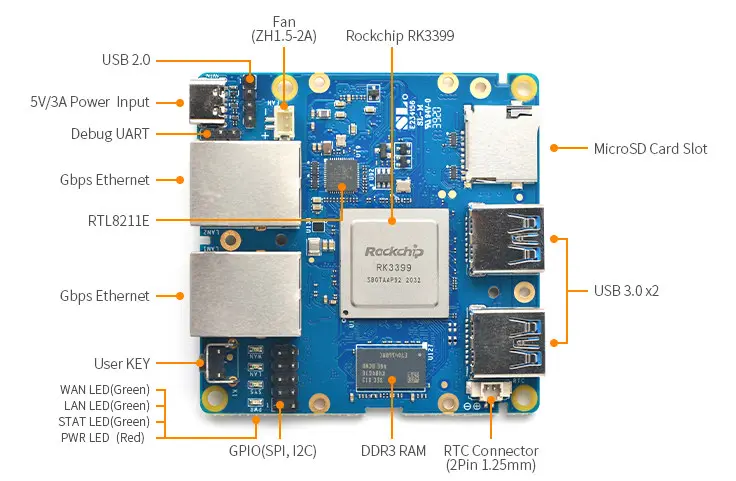
We have written several times about the NanoPi single board. Now there is information about a new representative of this family - a single-board headless-PC with an RK3399 processor and two gigabit Ethernet ports. This single-board device, unlike most of its "relatives", is not intended for use as a desktop. It has no video output. But it can be used for integration into server systems, DIY projects, etc.
This is facilitated by two Ethernet ports and two USB 3.0 ports. About what else the single-board can offer - under the cut.
NanoPi R4S specifications
- SoC - Rockchip RK3399 with dual-core Cortex-A72, quad-core Cortex-A53, plus Mali-T86 video chip with OpenGL ES1.1 / 2.0 / 3.0 / 3.1, OpenCL, DX11, AFBC support, 4K VP9 and 4K 10-bit H265 / H264 60fps.
- — 4 DDR3 1 DDR4.
- microSD.
- — 2 Ethernet.
- USB — 2x USB 3.0 Type-A USB 2.0.
- — 2*5 SPI l2C.
- — 3- UART.
- , power, SYS, LAN, WAN
- .
- — USB-C.
- — 66*66 .

Unfortunately, the developers, FriendlyELEC, have not announced prices yet, and there is no information about the software for this single board. However, the price is likely to be in the $ 50 range, with an initial cost of about $ 35 for a 1GB model and a ceiling of $ 60 for a 4GB model. That's how much the manufacturer asks for the NanoPi M4 SBC.
But there are already detailed diagrams for this single board , plus a PCB CAD file .
The predecessors of this single board, such as the NanoPi R2S, support U-boot, Ubuntu Core and OpenWrt. Most likely, the new system also works with this software. Perhaps the developers have added something else, but so far nothing is known about this - you need to wait for the official announcement with additional specifications.
In September, the same developer introduced NanoPi NEO3, an alternative to the Raspberry Pi 3 for networking projects. The company supplies boards based on both Ubuntu Core 18.04 FriendlyCore and OpenWrt FriendlyWrt, with Linux 5.4.12 kernel. You can connect to the device via GPIO using BASH. Users who have tested WiringPi for connection state that in some cases the board is not recognized by the software.

By the way, you can also make a supercomputer from NanoPi single-board devices . Just a few days ago, a translation of the manual for creating a cluster from NanoPi Fire3 was published on Habré. such a cluster can be used to solve resource-intensive tasks, including medical research, weather modeling, machine learning, and high availability services. Yes, this is not exactly the supercomputer that can figure in the top most productive systems in the world, but it is still more productive than most desktops and servers. The NanoPi R4S is, as far as we can tell, also suitable for this purpose.
